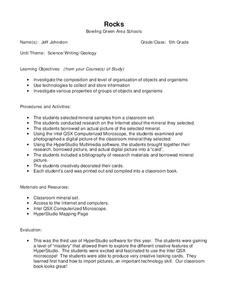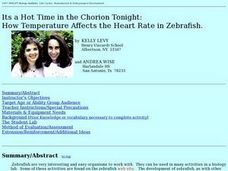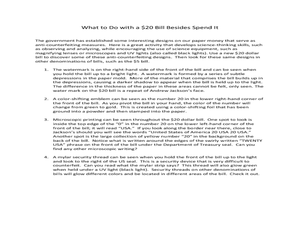Curated OER
Rocks
Fifth graders, while in the computer lab, investigate and study the composition and level of organization of objects and organisms and utilize technology to collect and store information collected. They explore, research and examine a...
Curated OER
Bacteria
Learners study the advantages and disadvantages of bacteria. In this bacteria lesson students draw and label the different types of bacteria.
Curated OER
Inventions 2: The Impact
Students explore innovators and inventions. In this technology lesson plan, students investigate the issues inventors face as they tackle new technology. Students design their own realistic needs-based invention.
Green Learning
Build Your Own Biogas Generator
Where this is not exactly a lesson plan, it is a terrific outline of how to generate biogas from an animal manure sample. If you are up for the challenge, the generator can be built by your class as a concluding project at the end of an...
Curated OER
What is the Rock Cycle and Its Processes?
Geology beginners examine three different rock samples and determine their origin by their characteristics. By making and recording observations, they become familiar with features of igneous, metamorphic, and sedimentary rock types....
Curated OER
Flour Beetle
Students observe the life cycle of the common flour beetle and make observations of its life stages. They also design and implement an investigation on food preference for the beetle and record data over a period of several months....
Curated OER
Chemosynthesis for the Classroom
Explorers set up Windogradsky columns with local mud so that they can culture microorganisms. After three and six weeks they make observations of the mud and the organisms growing in it. In this way they observe succession and relate...
Curated OER
Antonyms 1
Explore antonyms! There are 10 multiple-choice questions here, and learners must choose the answer that represents the opposite of the word in capital letters. Example words include buoyant, urban, and volatile.
Curated OER
Cell Observation Exercise
Students take measurements of the distance between the objective and the slide when in focus with each objective. They determine the diameter of the field of view at each power in order to determine the size of the cells being observed.
Curated OER
Cell Types and Parts
Eighth graders, after creating a Venn Diagram comparing/contrasting animal and plant cells, writing ten similes describing cell types, or drawing a colored diagram of a cell, list cell types as well as describe and label cell parts. They...
Curated OER
The Effects of Osmotic Balance and Imbalance In Living Cells
Students investigate osmotic balance in living cells. In this osmotic balance lesson plan, students use elodea leaves to study the effects of salt solutions on the cell. They compare the changes in an elodea leaf with salt water on it to...
Curated OER
Hawaii's Freshwater Ecosystems
Students examine brackish water. In this Science lesson plan, students observe organisms found in brackish water. Students record their observations of the various organisms.
Curated OER
Biomagnification
Students use real data to create an algebraic equation. They explain how the build up of small levels of contaminates can quickly become detrimental to species higher in the food chain.
Curated OER
Urban Effects on Inshore Plankton
Learners investigate the effects of urban pollution on plankton. For this plankton and pollution lesson plan, students use samples of plankton collected in urban areas to observe the effects of pollution on plankton samples. They...
Curated OER
It's Alive! Or is it...?
Students apply their knowledge of the characteristics of living things to unknown creatures to determine whether they can be considered "alive." They watch a Star Trek episode, then describe the characteristics of life.
Curated OER
The Science and Technology of Food
Students examine the guidelines the United States Department of Agriculture places on food. In groups, they create a list of the foods they consume and discuss the political and environmental implications of purchasing the food. They...
Curated OER
Microorganisms: Good Guys or Bad Guys?
Students discover the role microorganisms play in our lives. In this decomposition lesson, students examine decaying foods and plants in order to analyze the different bacteria that grows. Students discuss the good and bad of...
Curated OER
Dissolved Oxygen in an Aquatic Ecosystem
High schoolers explain why dissolved oxygen is important in aquatic ecosystems. They evaluate the optimal dissolved oxygen levels for living organisms.
Curated OER
Light and Optics
Third graders utilize the scientific method to explain light and optics in this five lessons unit. Through experimentation and discussion, 3rd graders canvass the concepts of light traveling, reflection and refraction.
Curated OER
Temperature Affects The Heart Rate
Young scholars relate heart rate and development to environmental conditions through experiment. In cooperative groups, students record the heart rate in developing zebra fish. Groups create a standard curve to predict the temperature...
Curated OER
What to Do with a $20 Bill Besides Spend It
Students explore the concept of anti-counterfeiting measure. For this economics lesson, students use science equipment to discover anti-counterfeiting designs. Students then explore other denominations of bills.
Curated OER
Theater Game: "The Good, the Bad, and the Bountiful"
Young scholars play a game to demonstrate the detrimental effects of an algal bloom on the environment. In this microorganism instructional activity, students discuss microbes and algae. They dramatize the effects of an algal bloom using...
Curated OER
What is Sand?
Learners complete a sand analysis project. In this sand grains lesson, students learn background information on how sand is formed and what sand grains are made of. Learners are given bags of sand and use them to complete a...
Curated OER
Plant and Animal Cells
Students investigate parts of a cell. In this plant cell lesson, students determine the difference between plant and animal cells. Students discover that coral is an animal based on cell characteristics. Students create puppets to...























